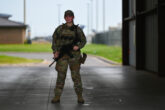August 29, 2021
Ignoring the National Guard is dangerous
At the last minute, Congress recently approved a funding plan to reimburse the National Guard Bureau for $500 million in expenses incurred while securing Washington following the Jan. 6 attack on the U.S. Capitol. Without the congressional deal, the Guard was at risk of a funding collapse. While this budget crisis put the problems facing the National Guard in stark relief, it is not the first challenge the Guard has faced in recent years.
On the heels of an Aug. 19 Capitol Hill bomb threat, an upcoming “Justice for J6” demonstration has prompted a complete activation of the D.C. police department. Given ongoing security concerns around the Capitol, the discussion around the potential role of the National Guard in an emergency situation is as urgent as ever. To avoid a national security emergency, policymakers in both the legislative and executive branches need to reassess how, when and why the Guard is utilized from both operational and readiness perspectives. The current path appears to be unsustainable.
The reliance on the National Guard to fulfill wartime personnel demands marks a transition from a strategic reserve to an operational reserve, in which the Guard meets similar requirements to active-duty troops without the necessary resources.
The Department of Defense (DOD) has relied on the Guard’s support for decades, placing great stress on the institution. Since 9/11, more guard units have been deployed overseas than at any time since World War II, indicating an enormous shift in the way the Guard is used. The reliance on the National Guard to fulfill wartime personnel demands marks a transition from a strategic reserve to an operational reserve, in which the Guard meets similar requirements to active-duty troops without the necessary resources. The past two years, though, have put a spotlight on the wide range of circumstances under which the Guard is called to serve: state missions, COVID-19 missions, missions at the southern border, securing the U.S. Capitol, and the presidential inauguration, as well as overseas missions.
Throughout 2020, the National Guard responded to a series of wildfires and civil unrest as they occurred across the country, while at the same time supporting the COVID-19 mission through testing, food banks, vaccinations and logistics. In 2020, the National Guard reported 11 million “man days,” compared to 2 million in 2019 — a 450 percent increase.
Read the full article from The Hill.
More from CNAS
-
National Security Human Capital Program
Defending the Army’s Command Assessment ProgramThe concept for CAP — developed during the first Trump administration — benefited from the guidance, input and oversight from the foremost scholar and practitioner on military...
By Katherine L. Kuzminski
-
National Security Human Capital Program
‘Women Don’t Just Achieve…They Excel’: Fmr. Marine Corps Attack PilotDr. Kyleanne Hunter, former Marine Corps attack pilot and CEO of Iraq & Afghanistan Veterans of America, says “women are the fastest growing group of veterans” and “the fastes...
By Dr. Kyleanne Hunter
-
National Security Human Capital Program
A Workforce Strategy for America’s Shipbuilding FutureThe future of American maritime dominance will not be determined solely by the number of ships launched or contracts signed, but rather by the strength and sustainability of t...
By Katherine L. Kuzminski & Laura Schmiegel
-
National Security Human Capital Program
Could the U.S. Bring Back the Draft?In this episode of At the Boundary, GNSI’s Dr. Guido Rossi sits down with Katherine Kuzminski, Director of Studies at the Center for a New American Security (CNAS), to explore...
By Katherine L. Kuzminski




